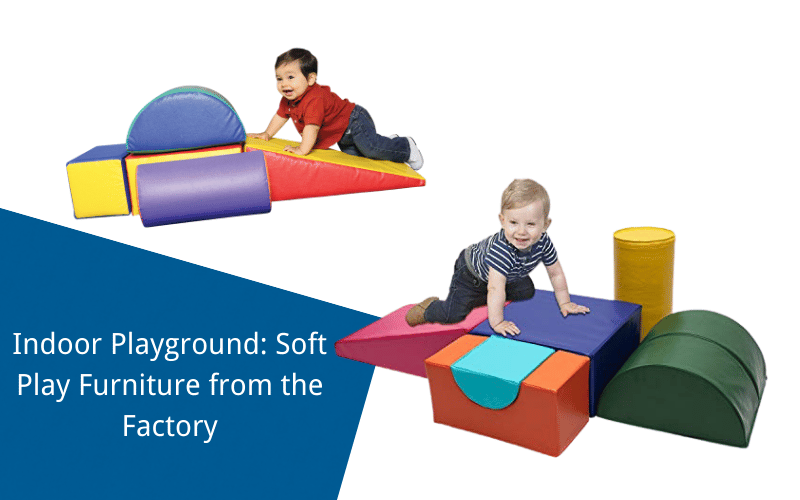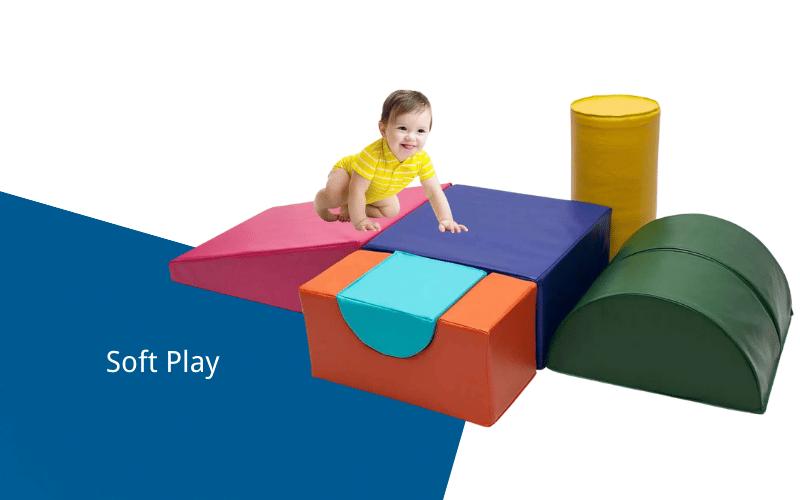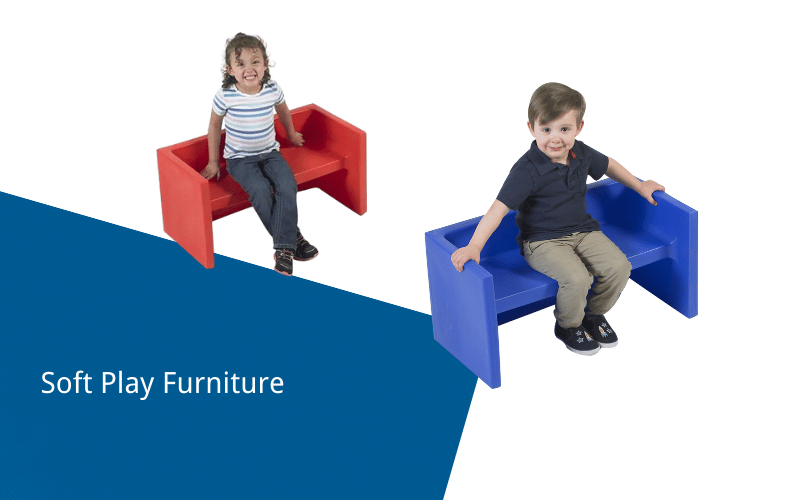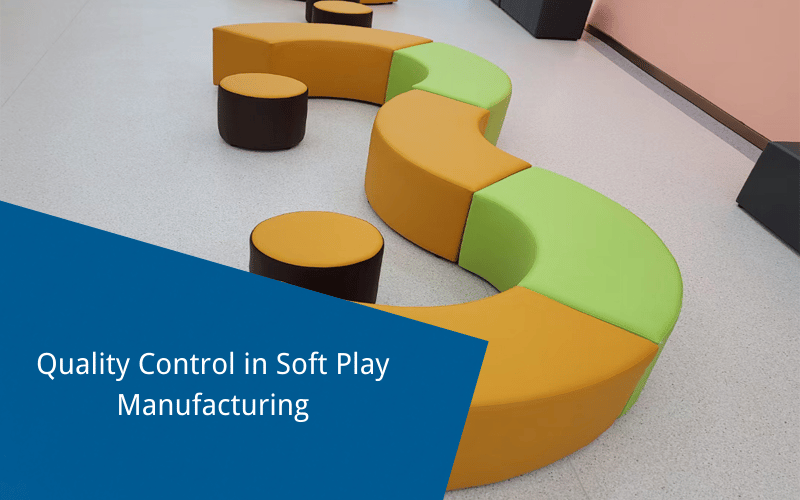Soft play areas are a cornerstone of indoor playgrounds, offering a safe, engaging, and imaginative environment for children to explore and develop. Designed with padded, foam-based equipment, these spaces prioritize safety while encouraging physical, cognitive, and social growth. From foam blocks and ball pits to sensory panels and themed zones, soft play equipment caters to younger children, providing low-impact activities that spark creativity and confidence. This guide explores the benefits, types, and customization options for soft play equipment, along with insights into its design, manufacturing, and role in creating dynamic indoor playgrounds.
Table of Contents
ToggleUnderstanding Soft Play in Indoor Playgrounds
What is Soft Play?
Soft play refers to a specially designed play area filled with padded, cushioned, and foam-based equipment that provides a safe and engaging environment for children. These areas are typically tailored for younger kids, offering low-impact activities that encourage exploration and creativity.
Soft play zones often include features such as foam blocks, padded climbing structures, and ball pits, all designed to minimize the risk of injury. They are commonly found in indoor playgrounds, family entertainment centers, and daycare facilities, providing a secure space for children to play freely.
Benefits of Soft Play for Children
Soft play offers numerous developmental and social benefits, making it an essential feature in indoor playgrounds.
- Physical Development: Activities like climbing, crawling, and balancing help improve motor skills, coordination, and overall physical fitness.
- Cognitive Growth: Interactive elements such as puzzles, sensory boards, and shape sorters stimulate problem-solving skills and creativity.
- Social Interaction: Soft play areas encourage children to interact with peers, fostering teamwork, communication, and sharing.
- Safe Exploration: The padded environment allows children to explore and take risks without the fear of serious injuries, boosting their confidence.
- Stress Relief: Playtime in a soft play area provides an outlet for energy and stress, promoting emotional well-being.
By incorporating soft play into your indoor playground, you create a space that supports holistic child development.
Types of Soft Play Equipment
Soft play equipment comes in various forms, each designed to engage children in different ways. Here are some common types:
- Foam Blocks and Shapes: These versatile pieces can be stacked, climbed, or used for imaginative play, helping children develop motor skills and creativity.
- Padded Climbing Structures: Small ramps, steps, and tunnels provide safe climbing opportunities for toddlers and young children.
- Ball Pits: Filled with colorful, lightweight balls, these areas offer sensory stimulation and endless fun for younger kids.
- Sensory Panels: Interactive boards with textures, mirrors, and moving parts engage children’s senses and encourage exploration.
- Soft Play Mats: Cushioned mats provide a safe surface for crawling, tumbling, and other activities, reducing the risk of injuries.
- Themed Play Zones: Custom-designed areas, such as castles or jungle adventures, add an imaginative element to the play experience.
By including a variety of soft play equipment, you can create a dynamic and inclusive environment that appeals to children of all ages and abilities.
Exploring Soft Play Furniture
Overview of Soft Play Furniture
Soft play furniture is a key component of indoor playgrounds, designed to provide a safe, engaging, and comfortable environment for children. These pieces are made from padded, lightweight materials that minimize the risk of injuries while encouraging imaginative and physical play.
Common examples of soft play furniture include foam seating, modular blocks, and themed structures like mini sofas or playhouses. These items are versatile, allowing children to climb, sit, or use them as props for creative activities. Soft play furniture is especially popular in toddler areas, daycare centers, and family entertainment facilities.
Durable Materials Used in Soft Play Furniture
The durability of soft play furniture is essential for withstanding heavy use in high-traffic environments. Manufacturers use high-quality materials to ensure longevity and safety.
- Foam Core: High-density foam forms the core of most soft play furniture, providing a firm yet cushioned surface that retains its shape over time.
- Vinyl Covering: Furniture is typically covered in durable, non-toxic vinyl that resists tears, stains, and moisture. This material is easy to clean, making it ideal for maintaining hygiene in busy play areas.
- Reinforced Stitching: Seams are reinforced with strong stitching to prevent wear and tear, ensuring the furniture remains intact even with frequent use.
- Non-Slip Bases: Many pieces feature non-slip bottoms to keep them stable during play, reducing the risk of accidents.
By using these materials, soft play furniture combines safety, durability, and ease of maintenance, making it a practical choice for indoor playgrounds.
Colorful Designs and Their Impact
The vibrant colors and playful designs of soft play furniture play a significant role in creating an inviting and stimulating environment for children.
- Attracting Attention: Bright, bold colors like red, blue, and yellow capture children’s attention and make the play area more appealing.
- Encouraging Creativity: Themed designs, such as animal shapes or fantasy castles, inspire imaginative play and storytelling.
- Promoting Learning: Some furniture incorporates educational elements, like numbers, letters, or shapes, to combine play with learning.
- Creating a Welcoming Atmosphere: A colorful and cheerful environment helps children feel comfortable and excited to explore the space.
By incorporating eye-catching designs, soft play furniture enhances the overall experience for children while contributing to the aesthetic appeal of the playground.
The Role of Factories in Crafting Soft Play Equipment
How Factories Produce Soft Play Furniture
Factories play a crucial role in crafting soft play furniture by combining advanced machinery, skilled labor, and high-quality materials. The production process typically involves several key steps:
- Design and Prototyping: Manufacturers start by creating detailed designs and prototypes based on customer requirements or market trends. This ensures the final product meets safety and functionality standards.
- Material Preparation: High-density foam is cut into specific shapes, while durable vinyl is measured and prepared for covering. These materials are chosen for their safety, durability, and ease of maintenance.
- Assembly: Foam cores are wrapped in vinyl covers, which are then stitched or heat-sealed to ensure a snug fit. Reinforced stitching and non-slip bases are added to enhance durability and stability.
- Finishing Touches: Themed designs, logos, or educational elements like numbers and letters are added to make the furniture visually appealing and engaging for children.
By following these steps, factories produce soft play furniture that is both safe and enjoyable for indoor playgrounds.
Quality Control in Soft Play Manufacturing
Quality control is a critical aspect of soft play manufacturing, ensuring that every piece of equipment meets safety and durability standards. Factories implement rigorous checks at various stages of the production process.
- Material Testing: Foam and vinyl are tested for strength, non-toxicity, and resistance to wear and tear. Only materials that meet strict safety criteria are used.
- Inspection During Assembly: Each piece is inspected during assembly to ensure proper stitching, secure fastenings, and accurate dimensions.
- Load Testing: Finished products are subjected to load tests to verify their ability to withstand heavy use without deforming or breaking.
- Safety Certification: Equipment is tested against industry standards, such as ASTM or EN certifications, to ensure compliance with safety regulations.
- Final Inspection: Before shipping, each item undergoes a final quality check to confirm it meets the manufacturer’s standards and customer specifications.
These quality control measures ensure that soft play equipment is safe, durable, and ready for use in high-traffic environments.
Customizing Soft Play Equipment
Customization allows businesses to create unique soft play equipment that aligns with their brand and caters to their target audience. Factories offer a range of customization options to meet specific needs.
- Themed Designs: Customers can choose from themes like jungles, space, or underwater adventures to create a visually engaging play area.
- Size and Shape: Equipment can be tailored to fit the dimensions of the play space, ensuring optimal use of available area.
- Branding: Logos, colors, and other branding elements can be incorporated into the design to enhance brand recognition.
- Educational Features: Numbers, letters, or puzzles can be added to promote learning through play.
- Special Features: Factories can include unique elements like interactive panels, sensory boards, or custom seating to make the equipment stand out.
By offering these customization options, manufacturers help businesses create soft play areas that are both functional and memorable.
Key Components of Indoor Playgrounds
Climbers and Their Importance
Climbers are a fundamental part of indoor playgrounds, offering children opportunities to develop physical strength, coordination, and confidence. These structures encourage active play and exploration, making them a favorite among kids.
- Physical Benefits: Climbing helps improve balance, motor skills, and muscle development. It also enhances hand-eye coordination as children navigate different grips and surfaces.
- Cognitive Growth: Climbers challenge children to think critically and plan their movements, fostering problem-solving skills.
- Social Interaction: Multi-user climbers encourage teamwork and communication as children share the space and take turns.
- Variety of Designs: Options range from rope nets and rock walls to themed structures like castles or trees, catering to different age groups and interests.
By incorporating climbers, you create a dynamic play environment that supports both physical and mental development.
Slides: Fun and Safety Considerations
Slides are a staple of indoor playgrounds, providing excitement and enjoyment for children of all ages. However, safety is a key consideration when selecting and installing slides.
- Material Selection: Use durable, non-toxic materials like high-density plastic or fiberglass to ensure longevity and safety.
- Design Features: Opt for slides with smooth edges, gentle slopes, and secure handrails to minimize the risk of injuries. Spiral, wave, and straight slides add variety to the play experience.
- Age Appropriateness: Include smaller slides for toddlers and more adventurous designs for older children to cater to a wide age range.
- Proper Installation: Ensure slides are securely anchored and positioned over impact-absorbing flooring, such as rubber mats or foam tiles.
By balancing fun with safety, slides can become a highlight of your indoor playground.
Creating Engaging Ball Pits
Ball pits are a classic feature of indoor playgrounds, offering sensory stimulation and endless fun for younger children. To make them engaging and safe, consider the following:
- Ball Quality: Use lightweight, non-toxic, and crush-resistant balls to ensure durability and safety.
- Depth and Size: Design the pit with an appropriate depth to allow children to immerse themselves while still being easy to navigate.
- Hygiene Measures: Implement regular cleaning protocols, such as sanitizing the balls and pit lining, to maintain a germ-free environment.
- Interactive Elements: Add features like slides, tunnels, or themed decorations to enhance the play experience.
- Safety Features: Use padded edges and non-slip flooring around the pit to prevent accidents.
A well-designed ball pit can become a focal point of your playground, attracting families and keeping children entertained.
Customizing Soft Play Equipment
Customization allows you to create unique soft play equipment that aligns with your playground’s theme and target audience.
- Themed Designs: Choose themes like jungles, space, or underwater adventures to make the play area visually appealing and immersive.
- Size and Shape: Tailor equipment to fit your available space, ensuring optimal use of the area.
- Branding: Incorporate your logo, colors, or other branding elements to enhance recognition and create a cohesive look.
- Interactive Features: Add sensory panels, puzzles, or educational elements to combine play with learning.
- Special Requests: Work with manufacturers to include unique features, such as custom seating or multi-functional pieces, to stand out from competitors.
Customizing soft play equipment helps you create a memorable and engaging environment that appeals to both children and parents.
Designing an Indoor Playground
Layout Considerations for Safety and Fun
A well-planned layout is essential for creating a safe and enjoyable indoor playground. Start by dividing the space into distinct zones to accommodate different activities and age groups.
- Safety First: Position high-energy activities like trampolines or climbing walls away from toddler areas to prevent accidents. Use safety barriers to separate zones and ensure clear pathways for easy navigation.
- Maximize Space: Utilize vertical space with multi-level play structures to make the most of smaller areas. This approach adds excitement while leaving room for other features like seating or storage.
- Supervision-Friendly Design: Arrange the layout so parents and staff can easily monitor all areas. Open sightlines and strategically placed seating enhance supervision and safety.
By prioritizing safety and functionality, you can create a layout that keeps children engaged while giving parents peace of mind.
Incorporating Mini Play Areas
Mini play areas are perfect for younger children or quieter activities, adding variety to your playground.
- Toddler Zones: Include soft play mats, foam blocks, and small slides to create a safe, low-impact environment for toddlers.
- Sensory Corners: Add interactive panels, mirrors, or tactile elements to stimulate sensory exploration and creativity.
- Quiet Spaces: Design cozy nooks with bean bags or soft seating for children who need a break from active play.
- Themed Mini Areas: Create small, themed zones like a mini kitchen or a pretend construction site to encourage imaginative play.
These mini areas provide options for children of all ages and energy levels, making your playground more inclusive and versatile.
Balancing Color and Functionality in Design
Color plays a significant role in making your indoor playground visually appealing, but it’s important to balance aesthetics with practicality.
- Bright and Inviting: Use bold, vibrant colors like red, blue, and yellow to capture children’s attention and create a cheerful atmosphere.
- Thematic Consistency: Choose a color palette that aligns with your playground’s theme, such as earthy tones for a jungle or cool blues for an underwater adventure.
- Functional Choices: Opt for materials and finishes that are easy to clean and maintain, especially in high-traffic areas.
- Zoning with Colors: Use different colors to define zones, making it easier for children and parents to navigate the space.
By thoughtfully combining color and functionality, you can create a playground that is both visually stunning and practical to maintain.
Customizing Soft Play Equipment
Customization allows you to tailor soft play equipment to your playground’s unique needs and branding.
- Themed Designs: Work with manufacturers to create equipment that matches your playground’s theme, such as pirate ships, castles, or space stations.
- Size and Fit: Customize the dimensions of equipment to maximize your available space and ensure a perfect fit.
- Brand Integration: Add your logo, brand colors, or custom graphics to reinforce your identity and create a cohesive look.
- Interactive Features: Include sensory panels, puzzles, or educational elements to enhance the play experience and add value for parents.
- Unique Elements: Request one-of-a-kind features like multi-functional pieces or themed seating to make your playground stand out.
Customizing soft play equipment helps you create a memorable and engaging environment that appeals to both children and their families.
Frequently Asked Questions
Q: What is a soft play factory and what do they offer?
A: A soft play factory specializes in designing and manufacturing soft play equipment and furniture, such as climbers, slides, ball pits, and activity mats. These factories create vibrant, colorful structures that encourage active play, imagination, and social interaction among children. They offer products for various age groups, including toddlers and infants, while ensuring safety and durability in all their designs.
Q: How does a soft play factory ensure safety standards?
A: Soft play factories prioritize safety by adhering to strict regulations and guidelines. They use high-quality, non-toxic materials that can withstand heavy use and conduct regular testing and inspections. This ensures that all products, including tunnels, slides, and climbing structures, meet safety requirements for commercial use in daycare centers, family entertainment facilities, and playgrounds.
Q: What types of soft play furniture can be found in a soft play factory?
A: Soft play factories offer a wide range of furniture, including soft seating, activity mats, foam blocks, and climbing structures. These pieces create cozy, interactive play spaces that encourage social interaction and imaginative play. The furniture often features vibrant colors and fun shapes, making it both functional and appealing to children.
Q: Can soft play equipment be customized for specific playground needs?
A: Yes, many soft play factories offer customization options to create unique play spaces tailored to specific needs. Customization can include themed designs, specific sizes, and features like tunnels or climbing structures that cater to the age and developmental stages of the children using the equipment.
Q: What is the importance of durable soft play structures for active play?
A: Durable soft play structures are essential for active play because they can withstand constant use by children. High-quality materials ensure that equipment like climbers, slides, and ball pits remain safe and functional over time. Durability reduces the need for frequent repairs or replacements, making it a cost-effective choice for facilities with regular play sessions.
Q: How do soft play factories contribute to early childhood development?
A: Soft play factories support early childhood development by creating equipment that promotes physical and cognitive growth. Play structures improve coordination, balance, and motor skills through active play. Interactive elements like tunnels and foam blocks encourage social interaction, helping children develop communication and teamwork skills in a fun, engaging environment.
Q: What should I consider when installing a soft play area?
A: When installing a soft play area, consider the available space, the age range of children using the facility, and the activities you want to promote. Ensure the layout allows for safe movement and interaction while including equipment like slides, climbers, and ball pits. Consulting with a soft play factory can help you design a space that meets your specific needs.
Q: What role does imagination play in soft play environments?
A: Imagination is vital in soft play environments, as it encourages children to engage in creative and role-playing activities. Soft play structures often serve as the backdrop for imaginative scenarios, inspiring kids to invent games and stories. This type of play supports cognitive development by fostering problem-solving, decision-making, and social skills.
Q: Why choose a soft play factory for a commercial playground installation?
A: Choosing a soft play factory ensures access to innovative, high-quality equipment designed specifically for children. These factories understand the unique demands of commercial spaces and provide products that meet rigorous safety standards while promoting active play and social interaction. Their expertise helps create vibrant, engaging playgrounds that attract families and enhance the play experience.
Concluding Summary
Soft play equipment is an essential feature of indoor playgrounds, combining safety, creativity, and functionality to create enriching play environments for children. By incorporating a variety of equipment types, such as foam blocks, climbing structures, and sensory panels, you can cater to diverse age groups and developmental needs. Customization options, vibrant designs, and durable materials further enhance the appeal and longevity of soft play areas. Whether you’re designing a new playground or upgrading an existing one, investing in high-quality soft play equipment ensures a memorable and secure experience for children, as well as peace of mind for parents.









